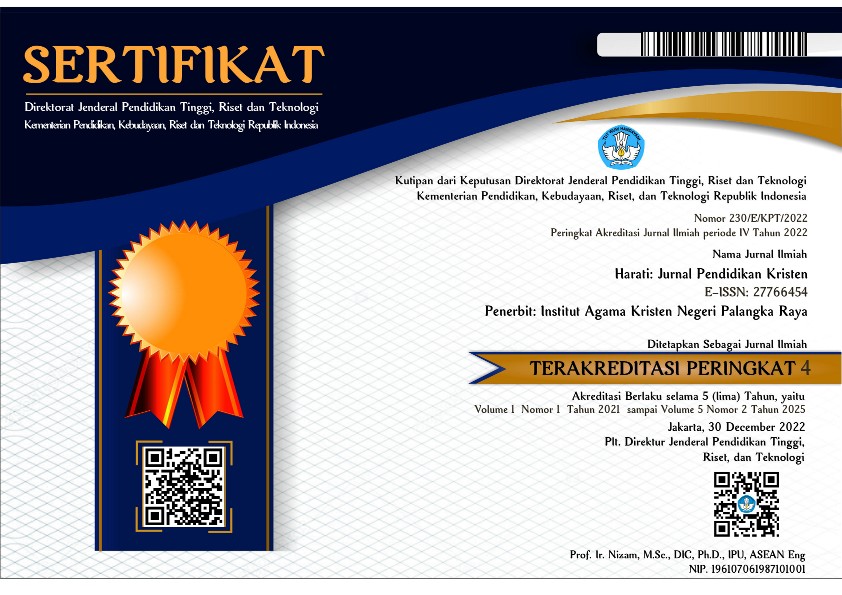Tongkonan as a Living Curriculum: Intergenerational Transmission of Torajan Cultural Knowledge through Spatial and Ritual Practices
DOI:
https://doi.org/10.54170/harati.v5i1.873Keywords:
hidden curriculum, indigenous knowledge, pedagogy, tongkonan, Torajan heritageAbstract
A key example of how cultural spaces transmit indigenous knowledge is the concept of traditional house of the Toraja people, the tongkonan. To comprehend the educational and cultural role of the tongkonan, this research explores its structural and symbolic aspects, rituals, and communal practices. Using a qualitative and ethnographic approach, the data were collected from participant observation, interviews and interdisciplinary analysis. Results illuminate that architectural design and symbolic carving of the tongkonan serves as pedagogical tools, and rituals and intergenerational exchanges collectively contribute to cultural continuity and communal identity. Yet modernization and globalization pose significant threats to the longevity of these practices, thus requiring creative adaptations, including digital documentation, community and social driven initiatives, and sustainable tourism models. These efforts not only protect Torajan cultural resources but also provide lessons for other indigenous people confronting similar predicaments. This research emphasizes the significance of the combination of traditional knowledge and contemporary practice to offer a crucial to the survival of cultures in a modern world.
References
Adams, K. M. (2021). Object in focus 6 Identity, heritage and memorialization: The Toraja Tongkonan of Indonesia. Writing Material Culture History, 105.
Adventin, F., & Hutubessy, F. (2021). Between the tongkonan building and the marampa’ church: The strategy of “adaptive space” for the Torajan migrant community in Jayapura City. Jurnal Sosiologi Dialektika, 16(1), 24. https://doi.org/10.20473/jsd.v16i1.2021.24-33
Aldana, M., & Sunarmi, S. (2021). Exploration aesthetic values and meaning local wisdom of tongkonan traditional houses as identity Toraja tribe society. Pendhapa, 12(2), 83-95. https://doi.org/10.33153/pendhapa.v12i2.4042
Amirullah, A. (2024). Tongkonan papa batu tumakke Toraja: An educational center for the culture and traditions of the Toraja society. Jurnal Ilmu Sosial Mamangan, 13(1), 84-94. https://doi.org/10.22202/mamangan.v13i1.7703
Ambtman-Smith, V. (2024). Incorporating First Nations, Inuit, and Métis traditional healing spaces within a hospital context: A place-based study of three unique spaces within Canada’s oldest and largest mental health hospital. International Journal of Environmental Research and Public Health, 21(3), 282. https://doi.org/10.3390/ijerph21030282
Barbaroux, A., Pourrat, I., & Bouchez, T. (2022). General practitioners and sales representatives: Why are we so ambivalent? PLOS ONE, 17(1), e0261661. https://doi.org/10.1371/journal.pone.0261661
Blatman, N., & Mays, K. (2022). Indigenous urbanisms. International Journal of Urban and Regional Research, 47(1), 106-109. https://doi.org/10.1111/1468-2427.13128
Chen, H. (2024). A study on the influence of learning space on students' intrinsic learning motivation. European Journal of Education, 59(3). https://doi.org/10.1111/ejed.12652
Colussi, C., Stafuza, M., Nepote, M., & Mendicino, D. (2022). Seroprevalence of Chagas disease in urban and rural indigenous populations of the south of Gran Chaco. Revista Da Sociedade Brasileira De Medicina Tropical, 55. https://doi.org/10.1590/0037-8682-0479-2021
Djafar, S. (2024). Literature review: Eksplorasi etnomatematika pada rumah adat (tongkonan) Tana Toraja. Journal on Education, 7(1), 3254-3263. https://doi.org/10.31004/joe.v7i1.6914
Eisenhart, M. (2021). The anthropology of learning revisited. Anthropology & Education Quarterly, 52(2), 209-221. https://doi.org/10.1111/aeq.12380
Ferguson, L., Girolami, T., Thorstad, R., Rodgers, C., & Humbert, M. (2021). “That’s what the program is all about… building relationships”: Exploring experiences in an urban offering of the indigenous youth mentorship program in Canada. International Journal of Environmental Research and Public Health, 18(2), 733. https://doi.org/10.3390/ijerph18020733
Guo, Y. (2024). An anthropological analysis of He Peng's works and transmission in Bayin Zuochang national music art education. IJSASR, 4(2), 327-342. https://doi.org/10.60027/ijsasr.2024.3994
Hipolito, M. (2024). A systematic literature review of the significance of the school of living tradition in the preservation of cultural heritage of the indigenous peoples. International Journal of Multidisciplinary Applied Business and Education Research, 5(2), 605-614. https://doi.org/10.11594/ijmaber.05.02.21
Kajanus, A. (2023). A developmental perspective on social status: Children's understanding of hierarchy in Nanjing and London. Journal of the Royal Anthropological Institute, 30(2), 478-496. https://doi.org/10.1111/1467-9655.14065
Kobong, T. (2008). Injil dan Tongkonan: Inkarnasi, kontekstualisasi, transformasi. BPK Gunung Mulia.
Kwame, A. (2021). Integrating traditional medicine and healing into the Ghanaian mainstream health system: Voices from within. Qualitative Health Research, 31(10), 1847-1860. https://doi.org/10.1177/10497323211008849
Masenya, T. (2022). Decolonization of indigenous knowledge systems in South Africa. International Journal of Knowledge Management, 18(1), 1-22. https://doi.org/10.4018/ijkm.310005
Millang, S. (2024). Ethnobotany of the Kombong agroforestry system and tongkonan conservation in the Toraja tribe, South Sulawesi, Indonesia. Forest and Society, 8(1), 271-295. https://doi.org/10.24259/fs.v8i1.31156
Moola, F. (2024). The potential for indigenous-led conservation in urbanized landscapes in Canada. Frontiers in Human Dynamics, 6. https://doi.org/10.3389/fhumd.2024.1340379
Muttaqin, Z. (2023). Optimizing the role of Islamic education and tongkonan in strengthening religious harmony in Tana Toraja. Fikrotuna Jurnal Pendidikan Dan Manajemen Islam, 12(2), 56-70. https://doi.org/10.32806/jf.v12i02.7352
Natsir, T. (2023). Visualization mapping of the socio-technical architecture based on tongkonan traditional house. JOIV International Journal on Informatics Visualization, 7(3), 1007-1015. https://doi.org/10.30630/joiv.7.3.1788
Putra, A. (2023). Ethnographic study of symbolic meanings in the Ma'nene' Toraja ritual series. Journal of Asian Multicultural Research for Social Sciences Study, 4(3), 1-6. https://doi.org/10.47616/jamrsss.v4i3.436
Putra, A. (2024). Ethnic value in Toraja’s social ritual: Cultural education perspective. Journal La Edusci, 4(5), 444-451. https://doi.org/10.37899/journallaedusci.v4i5.1010
Rombe, O., Goh, H., & Ali, Z. (2022). Toraja cultural landscape: Tongkonan vernacular architecture and Toraja coffee culture. Etropic Electronic Journal of Studies in the Tropics, 21(1), 99-142. https://doi.org/10.25120/etropic.21.1.2022.3822
Swiderska, K., Argumedo, A., Wekesa, C., Ndalilo, L., Song, Y., Rastogi, A., ... & Ryan, P. (2022). Indigenous peoples’ food systems and biocultural heritage: Addressing indigenous priorities using decolonial and interdisciplinary research approaches. Sustainability, 14(18), 11311. https://doi.org/10.3390/su141811311
Vries, H. (2021). Space for steam: New creativity challenge in education. Frontiers in Psychology, 12. https://doi.org/10.3389/fpsyg.2021.586318
Williamson, B., Provost, S., & Price, C. (2022). Operationalizing indigenous data sovereignty in environmental research and governance. Environment and Planning F, 2(1-2), 281-304. https://doi.org/10.1177/26349825221125496






